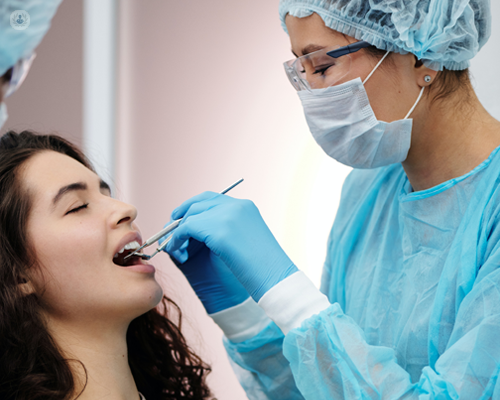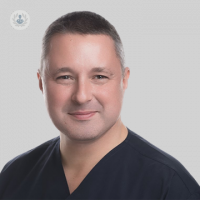Gum tissue graft surgery: correcting gum recession
Written by:Gum recession occurs as a result of over-brushing, smoking, or even certain genetic factors. The gum around the teeth decreases, leaving the tooth more exposed and can even progress to the exposure of the roots of the teeth. Esteemed London consultant implant and restorative dental surgeon, Dr Koray Feran, explains what gum graft surgery is and how it can treat gum recession and even prevent it from reoccurring.

What is a gum tissue graft, and how is it performed?
There are two ways a gum tissue graft can be done. The first is the use of the patient’s own gum which is taken from the palate. This is thick, hard tissue and also has the genetic code to change the tissue wherever it is placed so it will have the same qualities as the tissue from your palate.
The other option, instead of taking tissue from the palate, we can also use proprietary collagen from animals that has been processed in a certain way to bulk out the tissue and cover areas that have been previously exposed.
It’s used wherever there is gum recession around teeth, or where the roots of the teeth have been exposed, so rather than putting a filling on it we first put a gum graft on it. Also, it’s used where the gum has thinned over time or where teeth have been lost. If you are opting for a bone graft, you also need adequate, soft tissue thickness to be able to successfully cover a bone graft so that it heals properly.
How long does it take?
The surgery itself takes an hour or two but the healing time takes at least eight to twelve weeks before it becomes mature enough to be able to brush and eat properly. During that time, you have to be very careful with it. Avoid scrubbing it with a brush and be careful not to traumatise it.
But it is very predictable; if you get it right you can actually augment quite a large area of tissue. The nice thing about the palate is that the tissue will regenerate and if you need to go back a few months or a year later, you can take more tissue from the palate and it will just keep regenerating, giving you what's required for different areas of the mouth.
How will I know if a gum tissue graft is suitable for me?
If it is required, it’s suitable for you because very often we use your own tissue so there's no problem with using a different or foreign product. There is some soreness in two sites; of course, in the surgery site and the donor site in the palate but once they heal, they work very nicely. If we are treating very large areas or over bone grafts, then using proprietary collagen, which can come in bigger sheets, is a better idea and doesn’t require your own tissue to be harvested from the palate. However, for some areas, the palate tissue is better and it depends on the individual site that we are treating which we use.
How effective is it? What are the general results like?
If you have lost tissue, replacing it with your own tissue or a graft is very effective. It gives extra volume, stability, and a better appearance, and the nature of the tissue will change becoming tougher and more resistant to future recession.
The downside is, of course, that you are relying on a piece of tissue that you are taking from somewhere and putting it somewhere else. That tissue has to develop its own blood supply and if the surgery is unsuccessful, you can lose the tissue. If it gets traumatised or if it doesn’t work then you can actually end up with a result that is slightly worse than you started off with. It depends on the site as to how severe this might be.
Prior to the procedure, we will tell the patient what the risks are but, on the whole, in 95% of cases it will be successful and the additional tissue will become more stable over time.
How does recovery time differ from or compare to other dental procedures?
Regardless of the scope of the surgery, whether it's one site or the whole mouth, the speed of recovery is the same because all of the tissues are healing simultaneously at the same rate. You can’t really speed up the healing process and there are certain medical conditions that will slow down the recovery process. For example, if you are a smoker, you are a diabetic, or you have reduced vascularity in the area, then the result will be compromised. In some cases, we would probably advise the patient that it's not worth doing because the rate of success is much lower.
However, if you are a healthy patient with a good blood supply, then everything heals regardless of the site. Usually, there’ll be about a week of discomfort. We take sutures out normally in about two weeks but it takes about six to eight weeks for the tissue to mature enough for it to feel comfortable enough to brush properly. The longer you leave it, the better it gets.
When you look at gum grafts after a few years, you find that the tissue actually gets even better with time. It changes the underlying genetic code for the tissue so the new tissue that’s regenerated over time as your body turns over is actually better quality than before the procedure. There’s a long-term benefit that actually improves and matures with time.
If you are interested in booking a consultation with Dr Koray Feran, you can do so directly by visiting his Top Doctors profile.


